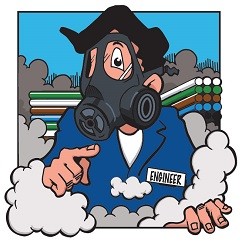Plastics and Outgassing
This topic does come up occasionally, especially when discussing the use of industrial plastics in high heat environments or in closed spaces. So what exactly is “outgassing”? Most plastics contain volatile organic compounds (VOCs). These are poisonous, carbon-containing chemicals that are volatile enough to evaporate even at room temperature.
The Smell Factor
PVC, or Polyvinyl chloride, is one of the best known plastics for its odour. These outgassing odours are most noticeable with new PVC products, but they diminish over time. For example, a shower curtain made with PVC can outgas for a month or longer and high temperature and humidity tend to speed up the process.
Application Concerns with Outgassing
One of the interesting discoveries concerning plastics is that the vacuum of outer space is an environment that brings about the highest rate of outgassing. As a result, the need for low-outgassing plastics was driven partly by the manufacturing needs of spacecraft, satellite and high altitude aircraft.
In addition, there are a number of high-tech applications that involve expensive optics (often encased in plastic housings) for example. For an electron microscope with an expensive lens and a large amount of wiring and cables within the instrument, outgassing from plastics is a concern. In addition, other highly sensitive instruments in the medical field and others also benefit from ultra-low outgassing properties.
So the question is, in regards to outgassing, what is considered low? Historically, standards were established for aerospace applications. But the absolute vacuum and extreme temperatures of aerospace applications are probably a bit much for most earth-bound applications. Consequently, most outgassing level requirements are often application dependent.
Safety Concerns with Outgassing
VOCs can be toxic. Direct contact can irritate eyes, noses and throats, causing coughing, headaches, dizziness and nausea. Usually these symptoms can be more noticeable when encountered in an enclosed space. Outgassing can also be triggered when:
The outgassing of volatiles is accelerated when the plastic is exposed to high temperatures and/or a vacuum. In certain applications it is required that there be no outgassing. In those cases a material must be selected that does not contain any plasticizers or other additives that can outgas. In those situations, plastics such as polycarbonate, acetals, nylons, and acrylics can be used.
Different plastics have different outgassing performance. PVC’s, for example, tend to be poor performers with high outgassing properties, while Fluoropolymers (PEEK, PTFE, etc.) tend to be the best plastics for low outgassing.
Which Plastics are the Best?
Many industrial applications for products using plastics involve either high-temperature environments, or devices being operated in a vacuum. Since both of these conditions trigger or accelerate outgassing, it becomes necessary to choose materials that demonstrate low outgassing properties. So what to use?
Here is a partial list of more common industrial plastics and their relative outgassing tendencies:
- Some fluoropolymers, such as polyvinylidene fluoride (PVDF), are suitable for use in a vacuum. They have low outgassing and are tolerant to higher temperatures.
- Another – polytetrafluoroethylene (PTFE) – is a synthetic fluoropolymer that is commonly used inside of vacuum systems. It, too, has low outgassing and is self-lubricating, a good electrical insulator, and tolerant to fairly high temperatures.
- PEEK (PolyEtherEtherKetone) is a low outgassing material as well as high temperature resistant
- Polycarbonates are good electrical insulators with moderate outgassing.
- Polyethylene (HDPE) requires thorough outgassing. While it is commonly used for a variety of consumer products, due its high outgassing rate, it is not a good choice for many industrial applications.
- PVC, despite its high outgassing rate, can be used in limited applications for rough vacuum lines.
- Nylon and Acrylics both have high outgassing rate and high affinity to water, making them unsuitable for many applications.
- Acetal although not especially low, is better than its close relative Delrin for lower outgassing levels
Outgassing During Fabrication
Since most cutting, shearing and drilling of plastic – especially polymers – will produce heat, it is safe to assume that some degree of outgassing is being generated. An old rule of thumb is, “If you can smell it, exhaust it.” This is especially true for PVC and Acrylics, which will release methyl methacrylate, a dangerous vapor when breathed, even in minute concentrations.
The actual data is seemingly incomplete and sometimes contradictory regarding the toxicity of outgassing during normal fabrication of components. However, it is always better to err of the side of caution when working with chemicals and volatile organic compounds (VOCs).
PVC and Vinyl Chloride
Vinyl chloride is a colorless gas at room temperature that has a mild, sweet odor. It is major component of polyvinyl chloride (PVC), which is used in many products, including automotive parts, furniture, and building materials. Inhaling vinyl chloride can cause sleepiness and dizziness, and in large amounts can cause loss of consciousness. However, its effects can be treated and most exposed persons recover completely.
A single small exposure is unlikely to cause delayed or long-term effects. Exposure to vinyl chloride over many years, however, can affect the liver, nervous system, and skin. Long-term exposure can cause a rare form of liver cancer. So the bottom line is to always ventilate properly and take precautions against outgassing.










